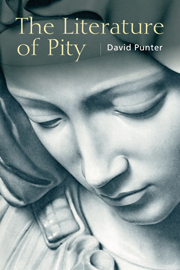Book contents
- Frontmatter
- Contents
- Plates
- Preface
- Acknowledgements
- 1 Distinguishing Pity
- 2 Pity and Terror: The Aristotelian Framework
- 3 Pietà
- 4 Shakespeare on Pity
- 5 The Eighteenth Century
- 6 Blake: ‘Pity would be no more …’
- 7 Aspects of Victoriana
- 8 Chekhov and Brecht: Pity and Self-Pity
- 9 ‘War, and the pity of War’: Wilfred Owen, David Jones, Primo Levi
- 10 Reflections on Algernon Blackwood's Gothic
- 11 Pity's Cold Extremities: Jean Rhys and Stevie Smith
- 12 Reclaiming the Savage Night
- 13 ‘Pity the Poor Immigrant’: Pity, Diaspora, the Colony
- 14 Lyric and Pity
- After Thought: Under the Dome
- Notes
- Bibliography
- Index
Preface
Published online by Cambridge University Press: 05 September 2014
- Frontmatter
- Contents
- Plates
- Preface
- Acknowledgements
- 1 Distinguishing Pity
- 2 Pity and Terror: The Aristotelian Framework
- 3 Pietà
- 4 Shakespeare on Pity
- 5 The Eighteenth Century
- 6 Blake: ‘Pity would be no more …’
- 7 Aspects of Victoriana
- 8 Chekhov and Brecht: Pity and Self-Pity
- 9 ‘War, and the pity of War’: Wilfred Owen, David Jones, Primo Levi
- 10 Reflections on Algernon Blackwood's Gothic
- 11 Pity's Cold Extremities: Jean Rhys and Stevie Smith
- 12 Reclaiming the Savage Night
- 13 ‘Pity the Poor Immigrant’: Pity, Diaspora, the Colony
- 14 Lyric and Pity
- After Thought: Under the Dome
- Notes
- Bibliography
- Index
Summary
I conceived of this book because it seemed – and still seems – to me that pity is a matter of real public urgency; always, perhaps, but at the present moment particularly, when we are witnessing unprecedented economic and cultural divides, both within the western world and between that world and its so-called ‘other’.
What, however, I had not anticipated was how deep a chord the concept of pity – and even the very mention of the word ‘pity’ – would strike. It is no exaggeration to say that everybody to whom I have talked, however briefly, about my topic has come up with their chosen questions, examples, doubts, illuminations. My thanks are due, therefore, to many of my colleagues at the University of Bristol and beyond, but also to a much broader swathe of friends and acquaintances, all of whose views have helped me in trying to address and enrich the topic.
But in the end, my intention has been to try to make this a very simple book. It is informed, I hope, by current thinking in literary and, indeed, psychoanalytic theory; but it is not a work of theory. Indeed, it may not even be a monograph; it looks most, I think, like a collection of essays – on different writers, different cultural trends, different moments of history – clustering around pity.
- Type
- Chapter
- Information
- The Literature of Pity , pp. v - viPublisher: Edinburgh University PressPrint publication year: 2014

